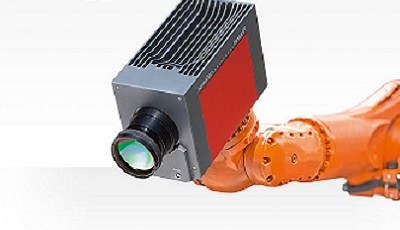InfraTec Participates in the EU's SPIRIT Project
08. Februar 2018
über
über

Introduction of robot-supported automatic inspection to become easier for users
Together with seven European partners from science and industry, InfraTec is working on next-generation inspection-robot technology as part of the EU research project SPIRIT. The technology will be used in industry for completely different inspection tasks – and with markedly simpler programming.
Inspection robots are used in industry more and more frequently for quality control of complex-shaped parts – until now in many cases for 3D-surface inspection, but increasingly also for alternative procedures, such as thermography or X-ray inspection. What all procedures have in common is that a sensor is moved over the surface of the part, so all relevant areas are inspected. But depending on the inspection procedure, the specific modes of operation and the resulting different requirements of the sensors in the inspection process must be considered in planning the robot's path. As a result, programming of an application-specific solution is usually a time-consuming task, and so expensive. Semi-automatic synchronisation and planning processes, in contrast, often lead to unsatisfactory results.
The three-year EU research project SPIRIT will now develop a system solution that can be equipped with a wide range of different inspection devices: video cameras for surface inspection, thermal imaging cameras for crack detection, X-ray sensors or 3D-sensors to check for completeness. Software for this is being developed that enables the robot to perform automatic path planning for each of these different inspection tasks. The system is simply fed by the CAD model of the component and – to prevent collisions – that of the work cell. It then automatically calculates the path for the robot, depending on the sensor system and inspection task.
In the project, sponsored by the European Union with the ID 779431 and part of the EU framework programme Horizon 2020, InfraTec will provide technology and know-how for thermal imaging inspection as one of the three specific applications for practical implementation. At the Austrian speciality steel manufacturer BÖHLER, a subsidiary of Voestalpine AG, crack detection of forged high-performance parts for aerospace, energy generation or drive technology will be automated using high-end thermographic technology from InfraTec. Other users in the project network are the FIAT Research Center, with automated inspection of engine assemblies, as well as the FACC company, manufacturer of CFC lightweight components for aviation and the automobile industry, where the goal is greater flexibility in non-destructive inspection of these high-tech components.
Together with seven European partners from science and industry, InfraTec is working on next-generation inspection-robot technology as part of the EU research project SPIRIT. The technology will be used in industry for completely different inspection tasks – and with markedly simpler programming.
Inspection robots are used in industry more and more frequently for quality control of complex-shaped parts – until now in many cases for 3D-surface inspection, but increasingly also for alternative procedures, such as thermography or X-ray inspection. What all procedures have in common is that a sensor is moved over the surface of the part, so all relevant areas are inspected. But depending on the inspection procedure, the specific modes of operation and the resulting different requirements of the sensors in the inspection process must be considered in planning the robot's path. As a result, programming of an application-specific solution is usually a time-consuming task, and so expensive. Semi-automatic synchronisation and planning processes, in contrast, often lead to unsatisfactory results.
The three-year EU research project SPIRIT will now develop a system solution that can be equipped with a wide range of different inspection devices: video cameras for surface inspection, thermal imaging cameras for crack detection, X-ray sensors or 3D-sensors to check for completeness. Software for this is being developed that enables the robot to perform automatic path planning for each of these different inspection tasks. The system is simply fed by the CAD model of the component and – to prevent collisions – that of the work cell. It then automatically calculates the path for the robot, depending on the sensor system and inspection task.
In the project, sponsored by the European Union with the ID 779431 and part of the EU framework programme Horizon 2020, InfraTec will provide technology and know-how for thermal imaging inspection as one of the three specific applications for practical implementation. At the Austrian speciality steel manufacturer BÖHLER, a subsidiary of Voestalpine AG, crack detection of forged high-performance parts for aerospace, energy generation or drive technology will be automated using high-end thermographic technology from InfraTec. Other users in the project network are the FIAT Research Center, with automated inspection of engine assemblies, as well as the FACC company, manufacturer of CFC lightweight components for aviation and the automobile industry, where the goal is greater flexibility in non-destructive inspection of these high-tech components.
Mehr anzeigen
Weniger anzeigen


Diskussion (0 Kommentare)